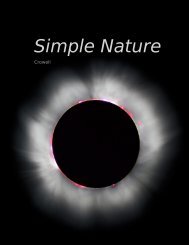Chapter 1 Conservation of Mass - Light and Matter
Chapter 1 Conservation of Mass - Light and Matter
Chapter 1 Conservation of Mass - Light and Matter
You also want an ePaper? Increase the reach of your titles
YUMPU automatically turns print PDFs into web optimized ePapers that Google loves.
c / As in figure b, an infrared<br />
camera distinguishes hot <strong>and</strong><br />
cold areas. As the bike skids to<br />
a stop with its brakes locked, the<br />
kinetic energy <strong>of</strong> the bike <strong>and</strong><br />
rider is converted into heat in<br />
both the floor (top) <strong>and</strong> the tire<br />
(bottom).<br />
a new form <strong>of</strong> invisible “mystery energy” that patches things up?<br />
This would be like balancing your checkbook by putting in a fake<br />
transaction that makes your calculation <strong>of</strong> the balance agree with<br />
your bank’s. If we could fudge this way, then conservation <strong>of</strong> energy<br />
would be untestable — impossible to prove or disprove.<br />
Actually all scientific theories are unprovable. A theory can<br />
never be proved, because the experiments can only cover a finite<br />
number out <strong>of</strong> the infinitely many situations in which the theory is<br />
supposed to apply. Even a million experiments won’t suffice to prove<br />
it in the same sense <strong>of</strong> the word “pro<strong>of</strong>” that is used in mathematics.<br />
However, even one experiment that contradicts a theory is sufficient<br />
to show that the theory is wrong. A theory that is immune to<br />
dispro<strong>of</strong> is a bad theory, because there is no way to test it. For<br />
instance, if I say that 23 is the maximum number <strong>of</strong> angels that<br />
can dance on the head <strong>of</strong> a pin, I haven’t made a properly falsifiable<br />
scientific theory, since there’s no method by which anyone could even<br />
attempt to prove me wrong based on observations or experiments.<br />
<strong>Conservation</strong> <strong>of</strong> energy is testable because new forms <strong>of</strong> energy<br />
are expected to show regular mathematical behavior, <strong>and</strong> are supposed<br />
to be related in a measurable way to observable phenomena.<br />
As an example, let’s see how to extend the energy concept to include<br />
motion.<br />
2.1.3 Kinetic energy<br />
76 <strong>Chapter</strong> 2 <strong>Conservation</strong> <strong>of</strong> Energy<br />
Energy <strong>of</strong> motion is called kinetic energy. (The root <strong>of</strong> the word<br />
is the same as the word “cinema” – in French, kinetic energy is<br />
“énergie cinétique.”) How does an object’s kinetic energy depend<br />
on its mass <strong>and</strong> velocity? Joule attempted a conceptually simple<br />
experiment on his honeymoon in the French-Swiss Alps near Mt.<br />
Chamonix, in which he measured the difference in temperature between<br />
the top <strong>and</strong> bottom <strong>of</strong> a waterfall. The water at the top <strong>of</strong><br />
the falls has some gravitational energy, which isn’t our subject right<br />
now, but as it drops, that gravitational energy is converted into kinetic<br />
energy, <strong>and</strong> then into heat energy due to internal friction in<br />
the churning pool at the bottom:<br />
gravitational energy → kinetic energy → heat energy<br />
In the logical framework <strong>of</strong> this book’s presentation <strong>of</strong> energy, the<br />
significance <strong>of</strong> the experiment is that it provides a way to find out<br />
how an object’s kinetic energy depends on its mass <strong>and</strong> velocity. The<br />
increase in heat energy should equal the kinetic energy <strong>of</strong> the water<br />
just before impact, so in principle we could measure the water’s<br />
mass, velocity, <strong>and</strong> kinetic energy, <strong>and</strong> see how they relate to one<br />
another. 3<br />
3 From Joule’s point <strong>of</strong> view, the point <strong>of</strong> the experiment was different. At<br />
that time, most physicists believed that heat was a quantity that was conserved














